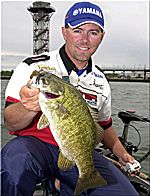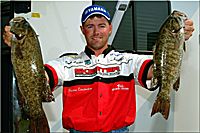
We all know what it's like to fish lakes that get pounded constantly by anglers. It seems that you cast until it hurts only to come in with an empty livewell. Though it isn't much fun, it is a lot less stressful than fishing for your paycheck.
Erie, Pennsylvania Bass Pro, and Bassmaster's Classic Qualifier Dave Lefebre experienced fishing in "high pressure" situations. On his way to qualifying for both the FLW Tour and the Bassmaster Tour, Dave endured some of the most demanding conditions. Like a true champion, Lefebre showed that he could be successfully consistent in these unpleasant circumstances.
During a conversation I had with Dave Lefebre, the d-coming superstar explained how he put together the fish he needed to make the Bassmaster Tour and qualify for the most prestigious tournament in the world Bassmasters Classic.
The Hudson River was the location for the last B.A.S.S. Northern Open and one of the most important tournaments of Dave's career. The anglers were prepared to face a tournament packed with challenging conditions like many times before.
"My goal in practice was to try to find areas that had a good concentration of fish," explained Lefebre. Unfortunately, this wasn't the case.
Not able to locate an area that he felt confident in, Dave was forced to reach into his bag of tricks and pull out the right combination of angling knowledge and lure selection. The first step was to downsize everything.
Lefebre introduced me to the term "minimizing hardware," which in a nutshell means to use the lightest line and tackle you can without compromising your ability to land quality fish. "I don't care what anyone says, when fish are extremely pressured and turned off, downsizing everything from your line size, hooks, snaps, and even split rings can make a difference," proclaims Lefebre.
On days one and two of the tournament, Lefebre concentrated on areas near creeks. His weapon of choice was the Luhr-Jensen Speed Trap. The high-performance design of the Speed Trap allowed Dave to crank the bait through the water at a high rate of speed, hoping to encourage a reaction strike.
The Speed Trap was attached to 12-pound test P-Line using an ultra-small size 1 Duo-Lock snap. The backbone of this team was a limber 7-foot medium action Rogue Rod Dave was using. It gave him the forgiveness needed to get a good hook set with such a fast retrieve. "I was reeling a 6:1 gear ratio Chronarch reel as fast as I could turn the handle. The Speed Trap is the only crankbait that runs true at that extreme rate of speed, and the strikes were vicious," Lefebre explains.
This pattern proved to be productive in attracting the fish needed to stay in contention; however, with the Tour Qualification clinched and the Classic now on the line, Dave decided to switch it up a bit on the last day.
Lefebre opted for a small homemade jig for day three, complemented by a Worminator Mini Chunk from Worminator Custom Hand Poured Baits. He also used a drop-shot rig equipped with a Gut Sack Minnow, also made by Worminator.

Dave had located a couple of critical areas that he believed held quality fish during days one and two of the tournament and opted to spend more time slowly dissecting these areas. He continually worked the jig over brush and scattered wood near a ledge. At low tide, the ledge was 6- to 8-feet deep, and at high tide between 9- and 11-feet deep. Although the area was known to hold a decent concentration of fish, Lefebre credited his ability to get a bit to the fact that he presented the fish with much smaller, more natural baits.
The small Telson Jig, which he designed, weighed in at 5/32 ounce. "The key factor that made the jig so effective was the 1 3/4-inch Worminator Mini Chunk", Lefebre said. The quality, texture, color, and the MegaStrike Formula attractant mixed in the plastic during the molding process is what makes this such a great jig trailer. "By mixing the MegaStrike Formula directly into the plastic during the molding process, it makes the scent stay with the bait forever," adds B.A.S.S. Touring Pro Rick Morris. "The more a Worminator Mini Chunk gets banged up, the more the scent gets released. The same holds true with the Gut Sack minnow. The buoyancy of these lures makes them excellent baits, not only for drop-shot fishing but also when fishing a Carolina rig. Unlike most other soft plastic products on the market, these baits do float", Morris said.
When selecting the proper color of bait to use, Dave explained that he tries to match it very closely with the water coloration. For most of the tournament on the Hudson River, Dave's color of choice was Green shad. "Subtle differences in coloration can increase your ability to catch fish in high-pressure situations," Lefebre said. "Worminator hand pours offer the most realistic transparent series of soft plastics I have ever seen, including subtle lines, backbones, and even the appearance of veins and gut sacks. Some even have eyes put in by hand", Lefebre explains.
Another critical ingredient to Lefebre's drop-shot technique was the Penetrator 3/16-ounce Tungsten Carbide weight. The extreme density of this weight makes it much more superior to lead in the ability to feel the weight and the bottom composition. Being a heavier metal gives you a smaller profile weight than one made of lead. For example, a 1/4-ounce Tungsten Carbide weight is approximately 30% smaller in size than a 1/4-ounce lead weight. This factor will also make it a lot easier to cast. These weights also come with a special coating that allows the weight to slide through weeds with very little resistance.
Dave finished the event in 27th place and the year ranked 5th, the final qualifying spot for the Bassmaster's Classic. "When conditions are as tough as they were this October on the Hudson, I rely on two techniques. They are exact opposites, but both can be very effective, fishing too fast or too slow. Covering a ton of water with a red Speed Trap to trigger reaction bites on days one and two put me in a position to advance to day three's top 50. Then, slowing down and pounding an area with the smaller jig and drop-shot closed the deal. Sometimes the hardest part is simply committing to one technique or the other in this case. However, both came into play and worked together perfectly", Lefebre explained.
My lengthy conversations with Dave Lefebre were probably some of the most informative conversations I have ever had in my life. Dave is such an intelligent guy, and I could spend hours talking to him on the phone and never get bored. I will put to use several of the techniques he explained to me for this article. Dave's pure confidence in the Worminator Custom Hand Poured Baits and the Penetrator Weights led me to some informative conversations with Bass Pro's Rick Morris, Sam Aversa, and Paul Higgins.
Rick Morris and Paul Higgins are the owners of Worminator Custom Hand Poured Baits. Sam Aversa is the owner of Penetrator Weights. The wealth of information these guys have amassed over the years about the products they produce is astounding. I am looking forward to writing a couple of articles soon, focusing solely on the advantages of using hand-poured baits and Tungsten Carbide weights. I was amazed when I heard the various details involved with the production of both products. If you are not using these products soon, you will be left behind in the competition.
Once again, I would like to thank Dave Lefebre, Paul Higgins, Sam Aversa, and Rick Morris for providing me with so much of their hard-earned knowledge. Keep your eyes out for the articles detailing the products I mentioned earlier because they have me so excited I can't wait to tell everyone about them. Until next time be safe and good luck.




